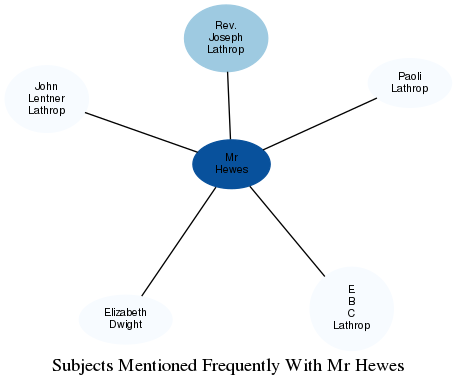Description
David Hewes (1822-1915) came to California in 1850, establishing a successful merchandise store in Sacramento that was destroyed by fire and flood in 1852 and 1853. He resettled in San Francisco and started a business clearing and leveling land, initially with hired Chinese laborers but later using heavy equipment including steam shovels and the first steam locomotive built, by him, on the West Coast. His extensive leveling efforts that made possible development of much of San Francisco earned him the nickname "the maker of San Francisco." He turned down the opportunity to join the "Big Four" railroad executives of the Central Pacific Railroad in developing the transcontinental railroad but maintained interest in the project and created and presented the "golden spike" that was symbolically struck to signify its completion in 1869. He was married in 1875 to widow Matilda Carolina (French) Gray (1833-1887) and the couple went on a two and a half year honeymoon to 22 countries with Matilda's daughter Franklina and sister Rosa. In 1877 they moved into a magnificent home in Oakland that is now a museum known as the Camron-Stanford House. Hewes ran for the Oakland City Council and was elected. Matilda suffered from bronchial ailments and complications and the Oakland climate made her worse. In 1881 they moved to Tustin, California, where Matilda's health initially improved. Hewes also bought a sheep ranch in Orange, California, near Tustin, that they called Anapauma, Spanish for "place of rest", immediately planting a raisin vineyard that quickly became profitable. After Matilda's death in 1887 the vineyard became diseased and all of the vines were finally removed in 1890. Hewes moved back to San Francisco in 1888 and renewed his acquaintance with Anna Maria Lathrop (1832-1892), and they were married in 1889. After a long honeymoon trip to Europe, the Middle East and New England, they returned to live in Anna's house in San Francisco along with Charles G. Lathrop and his daughter Jennie, who had been adopted by Anna. Anna fell ill around the time of the Stanford University dedication and died the following year, in 1892. In 1898 Hewes moved to Los Angeles and erected what became known as the Hewes Market, occupying nearly an entire block. In 1900 he moved back to the ranch which by that time had been replanted in oranges, lemons, olives and walnuts. He avoided the San Francisco earthquake of 1906 but his buildings in the city were destroyed. He rebuilt soon after and several of the city departments displaced by the destruction of City Hall temporarily occupied his new buildings. Hewes collected art and statuary from Europe and the Middle East, mummies from Egypt, that he donated to the Leland Stanford Jr. Museum. He served for many years as a trustee of Mills College and was a generous donor as well. His last years were spent managing the ranch at Orange.
Related Subjects

The graph displays the other subjects mentioned on the same pages as the subject "Mr Hewes". If the same subject occurs on a page with "Mr Hewes" more than once, it appears closer to "Mr Hewes" on the graph, and is colored in a darker shade. The closer a subject is to the center, the more "related" the subjects are.

